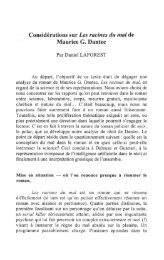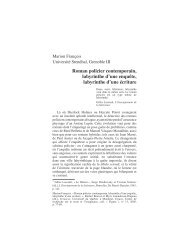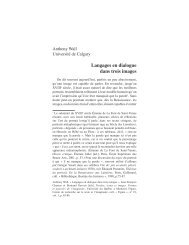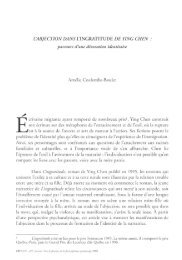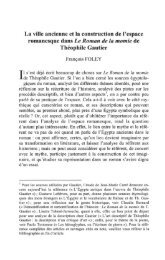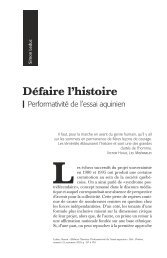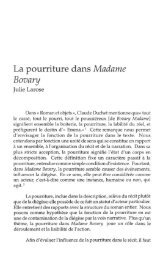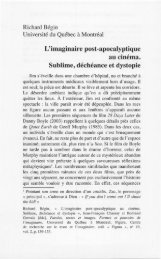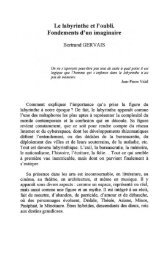Seeing and Believing in Dostoevsky's The Idiot - Observatoire de l ...
Seeing and Believing in Dostoevsky's The Idiot - Observatoire de l ...
Seeing and Believing in Dostoevsky's The Idiot - Observatoire de l ...
Create successful ePaper yourself
Turn your PDF publications into a flip-book with our unique Google optimized e-Paper software.
Thomas Epste<strong>in</strong><br />
Boston College<br />
<strong>See<strong>in</strong>g</strong> <strong>and</strong> <strong>Believ<strong>in</strong>g</strong> <strong>in</strong><br />
<strong>Dostoevsky's</strong> <strong>The</strong> <strong>Idiot</strong><br />
At the heart of Fyodor <strong>Dostoevsky's</strong> great, <strong>and</strong> murky,<br />
novel <strong>The</strong> <strong>Idiot</strong> lies a pa<strong>in</strong>t<strong>in</strong>g: Hans Holbe<strong>in</strong> 's naturalistic<strong>de</strong>votional<br />
masterpiece Der Leichnam Christi im Grabe<br />
(<strong>The</strong> Corpse of Christ <strong>in</strong> the Grave, 1521 ). As is weil known,<br />
<strong>Dostoevsky's</strong> "encounter" with the pa<strong>in</strong>t<strong>in</strong>g, <strong>in</strong> the Basel<br />
Art Museum <strong>in</strong> August 1867, was a <strong>de</strong>cisive <strong>and</strong> traumatic<br />
one, a <strong>de</strong>sperately ecstatic view<strong>in</strong>g that nearly resulted<br />
<strong>in</strong> an epileptic seizure.' Given the dialectical nature of 50<br />
much of <strong>Dostoevsky's</strong> th<strong>in</strong>k<strong>in</strong>g , it is perhaps no surprise<br />
that the pa<strong>in</strong>t<strong>in</strong>g 's suffocat<strong>in</strong>gly oppressive horizontality (its<br />
dimensions are 30.5 x 200 cm) <strong>and</strong> ail too humanly-<strong>de</strong>ad Christ<br />
should serve as a catalyst for the "solution" to the creative<br />
crisis surround<strong>in</strong>g the composition of <strong>The</strong> <strong>Idiot</strong>. 2 Fewer than<br />
live months later, on 1 January 1868 , he was able to <strong>de</strong>scribe<br />
1 After <strong>de</strong>scrib<strong>in</strong>g the agony of the experience, <strong>Dostoevsky's</strong> \Vife,<br />
Anna Snitk<strong>in</strong>a Dostoevsky, remarks that, upon leav<strong>in</strong>g the museum,<br />
Dostoevsky <strong>in</strong>sisted that they come back another time to see the<br />
pa<strong>in</strong>t<strong>in</strong>g aga<strong>in</strong>. See A. G. Dostoevskaia, Vospom<strong>in</strong>aniia (Moscow,<br />
1971 ), 165.<br />
2 As the Notebooks to the <strong>The</strong> <strong>Idiot</strong> attest, Dostoevsky had a very<br />
difficult time conceptualiz<strong>in</strong>g his protagonist (<strong>in</strong> the earlier drafts<br />
Myshk<strong>in</strong> was more like Raskol 'nikov of Crime <strong>and</strong> Punishment than<br />
the Pr<strong>in</strong>ce we know).lt was only when Dostoevsky settled on a more<br />
static, less dynamic concept of Myshk<strong>in</strong> that he was able to write the<br />
nove\. <strong>The</strong> letter to his niece below reflects that tum.<br />
Thomas Epste<strong>in</strong>, « <strong>See<strong>in</strong>g</strong> <strong>and</strong> <strong>Believ<strong>in</strong>g</strong> <strong>in</strong> <strong>Dostoevsky's</strong> <strong>The</strong> <strong>Idiot</strong> »,<br />
Jean-François Chassay et Bertr<strong>and</strong> Gervais [édsJ, Paroles, textes et images.<br />
Formes et pOl/voirs <strong>de</strong> l'imag<strong>in</strong>aire. Université du Québec à Montréal,<br />
Figura, Centre <strong>de</strong> recherche sur le texte et l'imag<strong>in</strong>aire, coll. « Figura »,<br />
n' 19, vol. 2, p. 109-121.
SEEING AND BELIEVING<br />
his project to his beloved niece Sofia Ivanova <strong>in</strong> the follow<strong>in</strong>g<br />
terms:<br />
<strong>The</strong> i<strong>de</strong>a of the novel is an old <strong>and</strong> favourite one<br />
of m<strong>in</strong>e, but such a hard one that for a long time<br />
1 didn't dare take it up, <strong>and</strong> if 1 have taken it up<br />
now, then absolutely because 1 was <strong>in</strong> a nearly<br />
<strong>de</strong>sperate situation. <strong>The</strong> ma<strong>in</strong> i<strong>de</strong>a of the novel is<br />
to portray a positively beautiful person. <strong>The</strong>re's<br />
noth<strong>in</strong>g more difficult than that <strong>in</strong> the who le<br />
world, <strong>and</strong> especially now. Ali the writers, <strong>and</strong><br />
not just ours, but even ail the European ones,<br />
who ever un<strong>de</strong>rtook the <strong>de</strong>piction of a positively<br />
[italics are Dostoevsky 's 1beautiful person, always<br />
had to pass. Because it's a measureless i<strong>de</strong>al. <strong>The</strong><br />
beautiful is an i<strong>de</strong>al, <strong>and</strong> the i<strong>de</strong>al-both ours <strong>and</strong><br />
that of civilized Europe-is far from hav<strong>in</strong>g been<br />
achieved. <strong>The</strong>re's only one positively beautiful<br />
person <strong>in</strong> the world-Christ, so that the appearance<br />
of this measurelessly, <strong>in</strong>f<strong>in</strong>itely beautiful person<br />
is <strong>in</strong> fact of course an <strong>in</strong>f<strong>in</strong>ite miracle.'<br />
Dostoevsky goes on <strong>in</strong> this letter to i<strong>de</strong>ntify a reveal<strong>in</strong>g<br />
genealogy for his novel, compris<strong>in</strong>g Don Quixote <strong>and</strong> the<br />
" <strong>in</strong>f<strong>in</strong>itely weaker" but nevertheless "enorlnous" achievement<br />
of Dickens's Pickwick. Both of those, he argues, succeed<br />
because they present the beautiful <strong>in</strong> the form of the<br />
" ridiculous," the comic, while Dostoevsky has <strong>in</strong> m<strong>in</strong>d a<br />
tragedy <strong>and</strong> presciently adds, "l'm terribly afraid that it will<br />
be a positive failure."4<br />
3 Fyodor Dostoevsky, Complete Lellers: 1868-1871, edited <strong>and</strong><br />
translated by David A. Lowe (New York: Ardis Publish<strong>in</strong>g, 1990)<br />
3: 17.<br />
4 Dostoevsky, Complete Lellers, 17. 1 have chosen to change one<br />
word <strong>in</strong> Lowe's translation of this phrase. While he has "absolute<br />
failure" 1 retum to the more literai "positive failure" (nollO)f(WrellbHlISI<br />
HeYlla'la <strong>in</strong> the Russian) because it more clearly l<strong>in</strong>ks the "failure" of<br />
the novel with the attempt to <strong>de</strong>pict Christ.<br />
[ 110]
SEEING AND BELIEVING<br />
What does Dostoevsky mean by this formulation? <strong>The</strong> word<br />
"positive," as seen <strong>in</strong> the excerpted letter above, is <strong>in</strong>itially<br />
used by Dostoevsky to <strong>de</strong>scribe the <strong>in</strong>carnation, the mak<strong>in</strong>g<br />
visible of the absolutely good <strong>and</strong> the beautiful <strong>in</strong> human form.<br />
For Dostoevsky, <strong>and</strong> for Christianity, this is of course a unique<br />
event; its appearance now, aga<strong>in</strong>, can only he <strong>in</strong> the form of<br />
imitation <strong>and</strong> will he, to take the second word, a necessary<br />
"failure" because the world <strong>in</strong> which it appears (or <strong>in</strong>to which<br />
it <strong>de</strong>scends, to use Vyacheslav Ivanov's formulationS) is<br />
neither positive nor beautiful. In the measurable, "real world"<br />
of nature <strong>and</strong> history, Myshk<strong>in</strong>'s goodness <strong>and</strong> beauty are<br />
perceived as "idiocy" <strong>and</strong>, still more troubl<strong>in</strong>g, prove to be a<br />
catalyst for chaos <strong>and</strong> tragedy, <strong>in</strong>clud<strong>in</strong>g his own. Myshk<strong>in</strong> is<br />
an enigma to those around him, un<strong>de</strong>rstood <strong>and</strong> misun<strong>de</strong>rstood<br />
<strong>in</strong> a variety of chang<strong>in</strong>g, literally contradictory ways. By Book<br />
4 even the narrator is unable to grasp him, or the go<strong>in</strong>gs-on<br />
swirl<strong>in</strong>g around him, fully.<br />
Myshk<strong>in</strong>'s tragedy, as the novel amply <strong>de</strong>monstrates, is a<br />
paradoxical one - a tragedy of <strong>in</strong>nocence, ofthe necessary guilt<br />
(<strong>and</strong> Myshk<strong>in</strong> repeatedly judges himself guilty) of <strong>in</strong>nocence.<br />
<strong>The</strong> un<strong>de</strong>rst<strong>and</strong><strong>in</strong>g of this doubleness, which ultimately<br />
perta<strong>in</strong>s to ail th<strong>in</strong>gs, ail experiences, cornes to Myshk<strong>in</strong><br />
gradually, <strong>in</strong> step with his grow<strong>in</strong>g simultaneous estrangement<br />
<strong>and</strong> participation <strong>in</strong> the world. It is fully half-way through the<br />
novel (Chapter Il, Book 2), <strong>and</strong> only <strong>in</strong> the form of comedy<br />
(another important duality <strong>in</strong> <strong>The</strong> <strong>Idiot</strong>), <strong>in</strong> a conversation with<br />
the boxer Keller, probably the novel's most socially <strong>de</strong>gra<strong>de</strong>d<br />
figure who cornes to the pr<strong>in</strong>ce both to seek forgiveness for<br />
hav<strong>in</strong>g conspired aga<strong>in</strong>st the pr<strong>in</strong>ce <strong>and</strong> to borrow 200 roubles,<br />
that Myshk<strong>in</strong> is able to give this perception a name: "double<br />
thoughts."6 This <strong>in</strong>sight, which is the foundation of the novel's<br />
, Vyacheslav Ivanov, Freedom <strong>and</strong> the Tragic Life: a study <strong>in</strong><br />
Dostoevsky (Wolfeboro, 1989).<br />
6 Pyodor Dostoevsky, <strong>The</strong> <strong>Idiot</strong>, translated by Richard Pevear <strong>and</strong><br />
Larissa Volokhonsky (New York, 200 1),309. In the Russian Aca<strong>de</strong>my<br />
edition Po/noe sobranie soch<strong>in</strong>enii (Len<strong>in</strong>grad, 1972),8: 258.<br />
[112]
THOMAS EPSTEIN<br />
tragedy, this experience that simultaneously exaggerates <strong>and</strong><br />
subsumes difference, is repeatedly, obsessively explored <strong>in</strong><br />
<strong>The</strong> <strong>Idiot</strong>: <strong>in</strong> dualities of character (for example: both with<strong>in</strong><br />
Nastasya Filippovna <strong>and</strong> between Nastasya Filippovna <strong>and</strong><br />
Aglaya Ivanovna, between Myshk<strong>in</strong> <strong>and</strong> Rogozh<strong>in</strong>, between<br />
Myshk<strong>in</strong> <strong>and</strong> Ippolit,etc.); <strong>in</strong> the <strong>in</strong>separability ofsuffer<strong>in</strong>g <strong>and</strong><br />
beauty; the simultaneity of immanence <strong>and</strong> transcen<strong>de</strong>nce (at<br />
one po<strong>in</strong>t, Myshk<strong>in</strong> shock<strong>in</strong>gly, <strong>and</strong> with a smile, calls himself<br />
a materialise); the coupl<strong>in</strong>g of the real <strong>and</strong> the symbolic. Also,<br />
<strong>in</strong> a novel notable for its crucial autobiographical sources, there<br />
is a no less strik<strong>in</strong>g, <strong>and</strong> ongo<strong>in</strong>g, exploration <strong>and</strong> commentary<br />
on the possibility of the novel itself, of the representability<br />
of "double thoughts," the collision between the planes of the<br />
div<strong>in</strong>e <strong>and</strong> the earthly, <strong>in</strong> word <strong>and</strong> image. <strong>The</strong> extraord<strong>in</strong>ary<br />
<strong>and</strong> repeated recourse to ekphrasis, the comucopia of pa<strong>in</strong>t<strong>in</strong>gs<br />
(sorne real, sorne imag<strong>in</strong>ary, sorne <strong>in</strong>conceivable) presented<br />
<strong>in</strong> the novel, <strong>and</strong> the explicit discussion of representation,<br />
comb<strong>in</strong>e to suggest that <strong>in</strong> <strong>The</strong> <strong>Idiot</strong>, more than <strong>in</strong> any other of<br />
<strong>Dostoevsky's</strong> novels, theological <strong>and</strong> existential discourses are<br />
<strong>in</strong>separably l<strong>in</strong>ked to the question of the status, <strong>and</strong> especially<br />
to the limits, of artistic representation, that is to say to the<br />
"pictur<strong>in</strong>g" of the <strong>in</strong>visible.<br />
<strong>The</strong> discourse on pa<strong>in</strong>t<strong>in</strong>g <strong>and</strong> vision beg<strong>in</strong>s rather early<br />
<strong>and</strong>, so to speak, <strong>in</strong>nocently <strong>in</strong> the novel: with a smalli<strong>and</strong>scape<br />
pa<strong>in</strong>t<strong>in</strong>g of the Swiss canton of Uri that Myshk<strong>in</strong> notices, <strong>and</strong><br />
recognizes, <strong>in</strong> General Epanch<strong>in</strong>'s office (Chapter two, Book<br />
One). This image is immediately followed by the discovery<br />
of the photograph of Nastasya Filippovna (given to Ganya<br />
as a k<strong>in</strong>d of punishment for his failure to give her a birthday<br />
present). <strong>The</strong>se two images , <strong>and</strong> especially their narrative <strong>and</strong><br />
symbolic connection, are not only crucial thematically (see<br />
below) but already <strong>de</strong>term<strong>in</strong>e <strong>and</strong> pre<strong>de</strong>term<strong>in</strong>e how Myshk<strong>in</strong><br />
will "see" both Nastasya Filippovna <strong>and</strong> Aglaya Ivanovna .<br />
In the Swiss l<strong>and</strong>scape, we realize several chapters later, lies<br />
Myshk<strong>in</strong>'s memory of Marie, a privileged image of suffer<strong>in</strong>g<br />
7 Dostoevsky, <strong>The</strong> <strong>Idiot</strong>, 387, Russian Aca<strong>de</strong>my edition , 321.<br />
[113]
THOMAS EPSTEIN<br />
Baptist.like the Holbe<strong>in</strong>, located <strong>in</strong> the Basel Kunstmuseum<br />
Myshk<strong>in</strong> <strong>de</strong>scribes ail the events lead<strong>in</strong>g up to a con<strong>de</strong>mned<br />
man's last moments; his fears <strong>and</strong> illusions, the ri<strong>de</strong> across<br />
the city, the f<strong>in</strong>al narrow stairs to the scaffold, even the rusty<br />
buttons on the executioner 's jacket; but it is the last moment<br />
itself, what he calls the "the cross <strong>and</strong> his face,"11 that is to be<br />
the portrait's actual subject. This existential moment of truth,<br />
this i<strong>de</strong>al pa<strong>in</strong>t<strong>in</strong>g provi<strong>de</strong>s a foreshadow<strong>in</strong>g of the end of the<br />
novel (both Nastasya Filippovna's <strong>de</strong>ath <strong>and</strong> Myshk<strong>in</strong>'s f<strong>in</strong>al<br />
fall <strong>in</strong>to idiocy) <strong>and</strong> a foreground<strong>in</strong>g of one of the novel's<br />
central questions: what k<strong>in</strong>d of beauty can there be, must<br />
there be <strong>in</strong> a world <strong>in</strong> which its most precious substance, the<br />
human be<strong>in</strong>g, is doomed to <strong>in</strong>evitable <strong>de</strong>ath? How to reconcile<br />
suffer<strong>in</strong>g <strong>and</strong> <strong>in</strong>justice with the beauty ofthe world, God's love,<br />
<strong>and</strong> the promise of eternallife? Perhaps most of ail for men of<br />
the 19 th century: how to-<strong>and</strong> why-ma<strong>in</strong>ta<strong>in</strong> one 's faith <strong>in</strong> an<br />
<strong>in</strong>visible beyond <strong>in</strong> the face of quite visible <strong>de</strong>cay <strong>and</strong> <strong>de</strong>ath? A<br />
tentative <strong>and</strong> perhaps unsatisfactory answer to these questions<br />
is immediately supplied when, giddy with Myshk<strong>in</strong>'s naïve<br />
honesty, the girls ask him to <strong>de</strong>scribe-to pa<strong>in</strong>t with wordstheir<br />
faces. Alex<strong>and</strong>ra's beauty, which Myshk<strong>in</strong> admires, he<br />
nevertheless calls "not joyful," of the type of the Darmstadt<br />
Madonna (by Holbe<strong>in</strong>, a copy of which Dostoevsky saw-<strong>and</strong><br />
was much impressed by-<strong>in</strong> Dres<strong>de</strong>n); ofAglaya (which means<br />
radiance <strong>in</strong> Greek), the nature of whose beauty wi Il ever escape<br />
Myshk<strong>in</strong>, he can only say "Beauty is a riddle,"12 apophatically<br />
renounc<strong>in</strong>g the very possibility of f<strong>in</strong>d<strong>in</strong>g the words/images<br />
to say or see it. He will, however, love her, that is to say will<br />
worship the very beauty that cannot be <strong>de</strong>picted (seen) because<br />
lack<strong>in</strong>g a natural mo<strong>de</strong>l From which to draw it (that is, Myshk<strong>in</strong><br />
"sees" Aglaya Ivanovna as exist<strong>in</strong>g on the "<strong>in</strong>nocent," nonmimetic<br />
13 si<strong>de</strong> of experience). In the midst of this discussion<br />
11 Dostoevsky, <strong>The</strong> <strong>Idiot</strong>, 66, Russian Aca<strong>de</strong>my edition, 56.<br />
12 Dostoevsky, <strong>The</strong> <strong>Idiot</strong>, 77, Russian Aca<strong>de</strong>my edition, 66. ln<br />
Russian: KpacOTa - 3arllAKa.<br />
13 By mimetic J mean here an ethical <strong>and</strong> aesthetic system based on<br />
[115]
SEEING AND BELlEVING<br />
of the beauty of the Epanch<strong>in</strong> girls, the photographie portrait<br />
of Nastasya Filippovna is <strong>in</strong>troduced, provok<strong>in</strong>g sc<strong>and</strong>ai,<br />
outrage, <strong>and</strong> awe. How can such a comb<strong>in</strong>ation of beauty <strong>and</strong><br />
suffer<strong>in</strong>g exist? It is here that A<strong>de</strong>laida famously eomments<br />
about Nastasya Filippovna: "Such beauty has power.... You<br />
can overturn the world with such beauty."14 Although applied<br />
here to the icon-portrait, these words equally <strong>de</strong>seribe the<br />
"double thoughts," the contradictory nature of the beauty that<br />
not only Nastasya Filippovna but Myshk<strong>in</strong> reveal-that they<br />
bear <strong>and</strong> bare-to the world.<br />
<strong>The</strong> <strong>in</strong>abil ity to represent i<strong>de</strong>al, non-experiential beauty<br />
cornes up aga<strong>in</strong> <strong>in</strong> Book Two, this time <strong>in</strong> connection to<br />
Myshk<strong>in</strong> himself. By now Aglaya Epanch<strong>in</strong> is un<strong>de</strong>r the<br />
ambiguous spell of the pr<strong>in</strong>ce, a1ternately lov<strong>in</strong>g <strong>and</strong> hat<strong>in</strong>g,<br />
worship<strong>in</strong>g <strong>and</strong> scorn<strong>in</strong>g him. In her m<strong>in</strong>d she has ma<strong>de</strong> of<br />
him a comb<strong>in</strong>ation of Pushk<strong>in</strong>'s Poor Knight <strong>and</strong> Cervantes's<br />
Knight ofthe Sorrowful Countenance. She has even, we learn,<br />
asked her sister A<strong>de</strong>laida to pa<strong>in</strong>t him on the basis of her<br />
<strong>de</strong>scription. But A<strong>de</strong>laida says it can't be done:<br />
"How could 1 pa<strong>in</strong>t it? And whom? <strong>The</strong> subject<br />
says about this 'poor knight':<br />
From his face the visor<br />
He ne'er raised for anyone.<br />
What sort of face could it be, then? What should<br />
1 pa<strong>in</strong>t-a visor? An anonymity?"15<br />
the imitation of a pre-existent, rule-bound natural or<strong>de</strong>r.<br />
14 Dostoevsky, <strong>The</strong> <strong>Idiot</strong>, 80, Ru ssian Aca<strong>de</strong>my edition, 69. <strong>The</strong><br />
Russian reads: TaKlUI KpacOTa - CIMa - ropSl4o CKa3aJIa Ai1eJtaHAa <br />
CTaKOIO Kpac(YroH MOlKHO MHp nepesepHyTb.<br />
l' Dostoevsky, <strong>The</strong> <strong>Idiot</strong>, 247, Russian Aca<strong>de</strong>my edition , 206.<br />
Pushk<strong>in</strong> 's Russian verse reads: C JlHl\a CTaJIbHOH peWëTKH 1HH npeA<br />
KeM He nOAbiMaJI. Significantly, although beyond the scope of these<br />
remarks, Nastasya Filippovna is able to create an imag<strong>in</strong>ary portrait<br />
of Myshk<strong>in</strong> (as Christ). See Book Three, Chapter 10.<br />
[116]
THOMAS EPSTEIN<br />
This confession of mimetic futility operates on at least<br />
two levels. With<strong>in</strong> the discourse of the novel, A<strong>de</strong>laida's<br />
words refer to the <strong>in</strong>comprehensibility, for the visible eye,<br />
of Myshk<strong>in</strong>'s pure <strong>in</strong>nocence: he is a mirror that reflects but<br />
does not project. To others his face thus appears as a mask,<br />
offer<strong>in</strong>g an <strong>in</strong><strong>de</strong>cipherable <strong>and</strong> fa<strong>in</strong>tly ridiculous figure . As a<br />
comment on the novel be<strong>in</strong>g written, this scene expresses the<br />
<strong>in</strong>herent impossibility of succeed<strong>in</strong>g at the task of a<strong>de</strong>quately<br />
<strong>de</strong>pict<strong>in</strong>g Myshk<strong>in</strong>. 16 As Myshk<strong>in</strong> will say of himself at the<br />
moment of his greatest self-un<strong>de</strong>rst<strong>and</strong><strong>in</strong>g: "1 lack the gesture.<br />
My gesture is always the opposite, <strong>and</strong> that provokes laughter<br />
<strong>and</strong> humiliates the i<strong>de</strong>a. l have no sense of measure either, <strong>and</strong><br />
that's the ma<strong>in</strong> th<strong>in</strong>g; that's even the most ma<strong>in</strong> th<strong>in</strong>g ."17 In<br />
this sense, to rema<strong>in</strong> true to his creation Dostevsky can only<br />
hope that the novel be a "positive failure."<br />
With the <strong>in</strong>troduction of the Holbe<strong>in</strong> pa<strong>in</strong>t<strong>in</strong>g, <strong>and</strong> its<br />
i<strong>de</strong>ntification with Rogozh<strong>in</strong>, all the stakes <strong>in</strong> the relationship<br />
between beauty <strong>and</strong> suffer<strong>in</strong>g, visible <strong>and</strong> <strong>in</strong>visible, mimesis<br />
<strong>and</strong> apophasis, are revealed. Symptomatically, Myshk<strong>in</strong> f<strong>in</strong>ds<br />
Rogozh<strong>in</strong>'s house by an act of mimetic perception: the hou se<br />
looks like Rogozh<strong>in</strong>, dark <strong>and</strong> forebod<strong>in</strong>g . And of course it<br />
is <strong>in</strong> this house that Myshk<strong>in</strong> sees the reproduction of Der<br />
Leichnam Christi im Grabe, which Myshk<strong>in</strong> now admits he<br />
saw <strong>in</strong> Basel <strong>and</strong> that he "cannot forget."1 8 Moreover: "He felt<br />
very oppressed <strong>and</strong> wanted to be out of the house quickly."19<br />
Myshk<strong>in</strong>, it becomes c1ear, is afraid of the pa<strong>in</strong>t<strong>in</strong>g, does not<br />
16 Radomsky is perhaps the clearest example of this phenomenon .<br />
As the novel's chief raisonneur, Radomsky rightly observes that<br />
Myshk<strong>in</strong> makes no sense, is self-contradictory; but by the end of the<br />
novel he nevertheless loves <strong>and</strong> serves the pr<strong>in</strong>ce.<br />
17 Dostoevsky, <strong>The</strong> <strong>Idiot</strong>, 552, Russian Aca<strong>de</strong>my edition, 458. This<br />
is part of the speech he gives at his failed com<strong>in</strong>g-out party <strong>in</strong>to<br />
Petersburg society. Also , note how Myshk<strong>in</strong> "quotes" <strong>Dostoevsky's</strong><br />
letter of 1 January on the matter of his fatal lack of measure .<br />
18 Dostoevsky, <strong>The</strong> <strong>Idiot</strong>, 218, Russian Aca<strong>de</strong>my edition, 181.<br />
19 Dostoevsky, <strong>The</strong> <strong>Idiot</strong>, 218, Russian Aca<strong>de</strong>my edition, 181 .<br />
[117]
THOMAS EPSTEIN<br />
reacted to the pa<strong>in</strong>t<strong>in</strong>g <strong>in</strong> fear, <strong>in</strong> effect betray<strong>in</strong>g Rogozh<strong>in</strong> .<br />
<strong>The</strong> challenge for Myshk<strong>in</strong> , the purpose of his earthly joumey<br />
<strong>and</strong> the source of his tragedy, is beg<strong>in</strong>n<strong>in</strong>g to become clear to<br />
him: he will both have to accept that mimesis (nature) ends <strong>in</strong><br />
<strong>de</strong>ath <strong>and</strong> sirnultaneously believe <strong>in</strong> a beauty that will save the<br />
world: there is no gnostic solution for him. <strong>The</strong> result is idiocy,<br />
apophatic faith <strong>in</strong> an apophatic image (the <strong>de</strong>ad Christ) through<br />
which he also sees the suffer<strong>in</strong>gs of Nastasya Filippovna.<br />
No less of a challenge to the k<strong>in</strong>gdom of the positively<br />
beautiful is n<strong>in</strong>eteen-year-old Ippolit Terentyev, who is<br />
dy<strong>in</strong>g of consumption. His reaction to the pa<strong>in</strong>t<strong>in</strong>g is not so<br />
much one of loss of faith as hatred for God's creation <strong>and</strong> for<br />
Myshk<strong>in</strong> himself (not only does Terentyev ironically utter<br />
the novel's most famous l<strong>in</strong>es, "<strong>The</strong> world will be saved by<br />
beauty,"21 words that he attributes to the pr<strong>in</strong>ce but which<br />
Myshk:<strong>in</strong> silently refuses to confirm, but he also <strong>in</strong>sistently<br />
pits Myshk:<strong>in</strong> 's love for "the trees of Pavlovsk" to his own<br />
love of the absurd, "Meyer's wall," onto which his squalid<br />
Petersburg room gives). In his read<strong>in</strong>g of the pa<strong>in</strong>t<strong>in</strong>g, Ippolit<br />
emphasizes the futility of beauty, the suffer<strong>in</strong>gs of the human<br />
Christ, the monstrous disproportion between God <strong>and</strong> man.<br />
As he says about the image of the <strong>de</strong>ad Christ <strong>in</strong> the grave:<br />
"Here the notion <strong>in</strong>voluntarily occurs to you that if <strong>de</strong>ath is so<br />
terrible <strong>and</strong> the laws of nature are so powerful, how can they<br />
be overcome? ... <strong>The</strong> pa<strong>in</strong>t<strong>in</strong>g seems precisely to express<br />
the notion of a dark, <strong>in</strong>solent <strong>and</strong> senselessly etemal power,<br />
to which everyth<strong>in</strong>g is subjected, <strong>and</strong> it is conveyed to you<br />
<strong>in</strong>voluntarily."22 This <strong>in</strong>sight leads him to the follow<strong>in</strong>g<br />
meditation on the very possibility of a transcen<strong>de</strong>nt image <strong>in</strong> a<br />
world based on <strong>de</strong>ath:<br />
And if this same teacher could have seen his<br />
own image on the eve of the execution, would he<br />
have go ne to the cross <strong>and</strong> died as he did? That<br />
21 Dostoevsky, <strong>The</strong> <strong>Idiot</strong>, 382, Russian Aca<strong>de</strong>my edition, 3 17.<br />
22 Dostoevsky, <strong>The</strong> <strong>Idiot</strong>, 408, Russian Aca<strong>de</strong>my edition, 339.<br />
[ 119]
SEEING AND BELIEVlNG<br />
question also cornes to you <strong>in</strong>voluntarily as you<br />
look at the pa<strong>in</strong>t<strong>in</strong>g.<br />
Ali this came to me <strong>in</strong> fragments, perhaps <strong>in</strong><strong>de</strong>ed<br />
through <strong>de</strong>lirium, sometimes even <strong>in</strong> images, for<br />
a whole half ho ur after Kolya left. Can someth<strong>in</strong>g<br />
that has no image come as an image?23<br />
Ippolit's words, <strong>in</strong><strong>de</strong>ed his life, are a direct challenge to<br />
Myshk<strong>in</strong>'s attempted faithful read<strong>in</strong>g of <strong>de</strong>ath, <strong>in</strong> which<br />
compassion, faith, <strong>and</strong> agape are the appropriate response to<br />
the suffer<strong>in</strong>gs of the mortal body. Ippolit's words also po<strong>in</strong>t<br />
explicitly to the 'idiocy' of Myshk<strong>in</strong>'s form of sacrificial<br />
mimesis (his imitat<strong>in</strong>g an image that is beyond aIl conception,<br />
outsi<strong>de</strong> of time <strong>and</strong> space). For Ippolit, who lives but rejects<br />
Myshk<strong>in</strong>'s path, there is only <strong>de</strong>s pair: rebellion aga<strong>in</strong>st life,<br />
rage, envy, <strong>and</strong> (failed) suici<strong>de</strong>. A negative apophasis.<br />
At the end of the novel, Myshk<strong>in</strong> is of course "saved,"<br />
ironically, from spiritual <strong>de</strong>ath, which he has come to i<strong>de</strong>ntify<br />
with experience, the fall <strong>in</strong>to time, nature, <strong>and</strong> mimesis, by<br />
idiocy, epilepsy, the absurd that is faith. <strong>The</strong> world, however, is<br />
not so lucky: it rema<strong>in</strong>s bound by experience, by time, nature,<br />
<strong>and</strong> history. Like Dostoevsky before Holbe<strong>in</strong>'s pa<strong>in</strong>t<strong>in</strong>g, we<br />
st<strong>and</strong> before the nove\. Nastasya Filippovna is <strong>de</strong>ad, Myshk<strong>in</strong><br />
an idiot, Aglaya ru<strong>in</strong>ed, Rogozh<strong>in</strong> unchanged. What does it<br />
ail mean? What beauty? <strong>The</strong> frame of Holbe<strong>in</strong>'s pa<strong>in</strong>t<strong>in</strong>g,<br />
<strong>in</strong> the form of a coff<strong>in</strong>, can perhaps serve as an i<strong>de</strong>al fram.e<br />
for our read<strong>in</strong>g, a <strong>de</strong>marcation between time <strong>and</strong> eternity,<br />
mimesis <strong>and</strong> apophasis. With<strong>in</strong> the frame we have noth<strong>in</strong>g<br />
but the <strong>de</strong>ad Christ (that is Myshk<strong>in</strong>, or almost Myshk<strong>in</strong>), a<br />
picture of absolute kenosis, an image of no image, where there<br />
is noth<strong>in</strong>g to susta<strong>in</strong> the vision of beauty, div<strong>in</strong>ity, eternity;<br />
on the other si<strong>de</strong> of the frame, <strong>in</strong>visible, we have only faith,<br />
a read<strong>in</strong>g not between but beyond the l<strong>in</strong>es. <strong>The</strong> beauty that<br />
susta<strong>in</strong>s us is beyond us, at least if we walk <strong>in</strong> Myshk<strong>in</strong>'s<br />
23 Dostoevsky, <strong>The</strong> <strong>Idiot</strong>, 408, Russian Aca<strong>de</strong>my edition, 339.<br />
[120]
THOMAS EPSTEIN<br />
shoes. His terrible joumey tracks the grow<strong>in</strong>g realization of<br />
the implications, <strong>in</strong><strong>de</strong>ed the salvific necessity, of his idiocy.<br />
Myshk<strong>in</strong>'s mean<strong>in</strong>g-<strong>and</strong> <strong>in</strong> this he is Nastasya Filippovna's<br />
double-is not fully accessible <strong>in</strong> this world, least of ail to<br />
himself; <strong>and</strong> yet the story Dostoevsky tells can only be told<br />
<strong>in</strong> this world. It is this tragic task, this embodiment of the<br />
dissonance between aesthetic <strong>and</strong> existential planes, between<br />
the visible <strong>and</strong> <strong>in</strong>visible, that <strong>The</strong> <strong>Idiot</strong> seeks to <strong>in</strong>carnate.<br />
[ 121)



